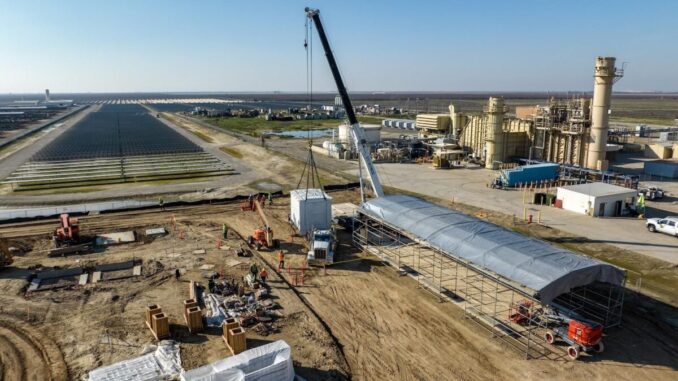
When we think of energy sector emissions, we tend to think of electricity. But the electricity grid only accounts for one-third of fossil fuel emissions: the direct combustion of fossil fuels, used to power industrial processes and heat buildings, has an emissions profile roughly the same as the electricity sector in the U.S. and other countries.
One of the biggest opportunities to eliminate these emissions is in the industrial sector, the single largest source of global emissions. The heat that powers industrial processes, such as the production of steel and chemicals, accounts for two-thirds of industrial energy demand and the majority of industrial emissions.
The electrification of industrial heat with renewable generation not only has the potential to bend the curve towards net-zero—it has the potential to open up one of the biggest and most actionable opportunities that the solar industry has ever seen.
Thermal batteries
At first glance, the intermittency of renewable generation seems to pose a massive problem for decarbonizing industrial facilities, which require process heat every hour of every day. But, when paired with new low-cost thermal battery technologies, solar and wind can unlock the decarbonization of process heating, creating a massive new market for renewable generation.
While easily achievable from a technology perspective, electrifying industrial heat has rarely been economical to date: using grid electricity to create industrial heat is about five times more expensive than burning natural gas onsite. Ultra-low power prices during peak renewable-generating hours enable electrified heat to undercut fossil fuels on cost, but only for a small portion of the time. Traditional energy storage technologies like lithium-ion batteries certainly have the potential to smooth out this variability, but they add costs that largely negate the benefits of cheap renewable electricity.
Industry, however, has a key advantage that unlocks the potential of renewables: most industrial energy use is in the form of heat. Instead of storing electricity and then turning it into heat, we can immediately convert the electricity into heat and then store that heat using low-cost, scalable, and abundant materials. In this approach, low-cost electricity is used to heat up a “thermal battery” to hundreds or thousands of degrees, which can store that heat for hours or days and output it on-demand.
Thermal batteries are a radically simple approach to energy storage, circumventing a reliance on expensive and scarce minerals in favor of low-cost materials like carbon, which is used by companies such as Antora Energy. Carbon is about 50 times less expensive than traditional battery materials and has about three times the energy density of lithium-ion. And with a supply chain of over 30 million tons every year—more than 50 times that of lithium—it can quickly scale up alongside demand.
Using thermal batteries, industrial facilities around the world are already turning electrification from impractical to profitable.
Electrifying heat loads
Thermal batteries open a path to rapidly build a decarbonized energy system that circumvents one of the biggest barriers to deploying new wind and solar generation: interconnection.
The Biden Administration is taking important steps to reform the years-long interconnection process for new-build renewables, and thermal batteries can offer an important complementary approach by enabling clean energy projects to make greater use of existing generator interconnections or circumvent the grid entirely.
First, thermal batteries create an opportunity to double the amount of renewable generation capacity installed at already approved interconnections through a “net-zero interconnection,” a process in which new wind or solar is added to an existing project without changing its maximum power output to the grid. By adding thermal batteries alongside new generation, excess power can be used to charge the thermal battery behind-the-meter—avoiding the need to upgrade the grid connection and wait in lengthy interconnection queues.
When renewable generation is lower, the new capacity can be exported to the grid through the already-approved but previously underutilized interconnection, effectively “firming” the renewable resource from the perspective of the grid. Such net-zero interconnections can forgo the need for new siting and interconnection while accelerating the pace of renewable energy deployment.
In other cases, new renewable power projects could avoid interconnection to the grid entirely while still directly offsetting fossil fuel combustion. By pairing new renewable power development with large, steady, and year-round energy loads, thermal batteries can enable industrial facilities to serve as a reliable offtaker of all of the energy generated by a wind or solar project.
For developers and financiers, thermal batteries open up thousands of new solar and wind projects that offer a unique hedge against many of the development risks and barriers that projects face today. By unlocking a reliable long-term offtaker that circumvents power market congestion and grid connection wait times, thermal batteries can reduce project risk and cut off years of expensive waiting time.
These factors combine to create robust, financeable projects, all enabled by a low-risk storage technology that reconfigures proven systems to convert electricity into heat and store it for days on end.
Cross-sectoral decarbonization
As solar and wind continue to saturate markets such as California and the U.S. Midwest, we’re beginning to see the problems of renewable overproduction, which causes power prices to crash as generation approaches or exceeds demand. When powered by thermal batteries, thermal loads have the potential to mitigate issues of overproduction by providing a large, flexible source of demand for renewable energy during peak generating hours.
As more and more of our economy is electrified, we need to lean into the advantages of wind and solar—namely, their ability to produce ultra-low-cost energy when the sun is shining or the wind is blowing—to cost-effectively decarbonize across sectors. In doing so, we have an opportunity to circumvent the biggest barriers to the growth of renewables, avoiding curtailment and interconnection issues. In the industrial sector, thermal batteries are the key that unlocks this potential, with the ability to catalyze gigawatts of new projects and eliminate gigatons of industrial emissions.
